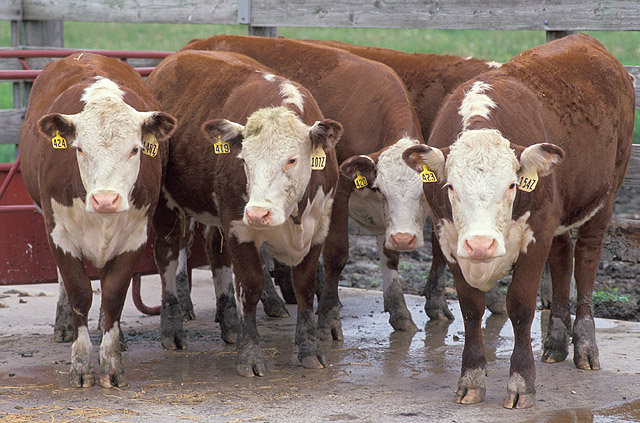It’s hard to draw any other conclusion from Michael Moss’s New York Times blockbuster investigative piece on E. coli in industrial beef, which is centered on the plight of Stephanie Smith, a young dance instructor left comatose, near death and now paralyzed from eating a single Cargill hamburger. Of course, a “single hamburger” can include meat from hundreds, some would say thousands, of animals. As Moss puts it:
Ground beef is usually not simply a chunk of meat run through a grinder. Instead, records and interviews show, a single portion of hamburger meat is often an amalgam of various grades of meat from different parts of cows and even from different slaughterhouses. These cuts of meat are particularly vulnerable to E. coli contamination, food experts and officials say. Despite this, there is no federal requirement for grinders to test their ingredients for the pathogen.
This is why a food safety expert who helped develop tracking systems for E. coli in meat can declare that, “Ground beef is not a completely safe product.” No kidding. The problem, however, is not with E. coli in general. The problem is that the particular strain of E. coli which infected Smith — known as E. coli O157:H7 — is virulent, deadly, persistent and endemic in industrial beef. How virulent, deadly and persistent? This much:
Food scientists have registered increasing concern about the virulence of this pathogen since only a few stray cells can make someone sick, and they warn that federal guidance to cook meat thoroughly and to wash up afterward is not sufficient. A test by The Times found that the safe handling instructions are not enough to prevent the bacteria from spreading in the kitchen.
In other words, if a piece of infected meat ends up in your kitchen, you are almost guaranteed exposure to it no matter how carefully you handle it. And how endemic? This year alone almost half a million pounds of E. coli infected ground beef have been recalled nationwide (and that doesn’t include the 800,000 pounds of Cargill beef recalled for contamination with antibiotic-resistant salmonella). Indeed, if Moss’s work proves anything, it’s that the safety systems in industrial beef processing are both barely functioning and almost fully opaque. And while the government is able to peek behind the curtain at these massive slaughterhouses and processing facilities, it seems far more concerned with protecting companies’ intellectual property than with the public health:
The meat industry treats much of its practices and the ingredients in ground beef as trade secrets. While the Department of Agriculture has inspectors posted in plants and has access to production records, it also guards those secrets. Federal records released by the department through the Freedom of Information Act blacked out details of Cargill’s grinding operation that could be learned only through copies of the documents obtained from other sources. Those documents illustrate the restrained approach to enforcement by a department whose missions include ensuring meat safety and promoting agriculture markets.
In one of the most chilling, and I thought devastating, quotes in the entire piece, a top official at the USDA’s Food Safety and Inspection Service observed that his options were somewhat limited since he had to “look at the entire industry, not just what is best for public health.” Note the fact that his phrasing sets the meat industry’s needs at odds with ours — the two can’t be reconciled in his eyes. What does that say about the government’s ability to ensure a safe food supply? No matter how you structure it, the industry now appears too big and too powerful to be regulated. What other explanation is there for the fact that the top food safety job at the USDA remains unfilled if not regulatory paralysis — the meat industry seems to have veto power over its regulators and hasn’t found a federal overseer to its liking.
One area that Moss does not cover is how E. coli O157 got into industrial beef in the first place. In fact it’s there because of the meat industry’s insistence on feeding cows corn — something they cannot easily digest — instead of grass. Among other things, corn feeding requires cows to be fed a steady dose of antibiotics, which has led to the rise of antibiotic resistance among various pathogens. But more importantly, it has caused very real changes in the cow’s gut which has allowed this toxic strain of E. coli to take hold, a strain that research suggests cannot survive in the gut of cows that eat only grass.
In short, E. coli didn’t just “happen” to the meat industry — it’s a consequence of industrial practices. But nowhere in the article (or in the halls of the USDA or the largescale beef producers for that matter) is the possibility of moving away from this corn-based system raised as a solution for the industrial system. Surprisingly, the article includes virtually no proposed solutions for this crisis — just vague assurances that the USDA isn’t “standing still” on the issue. In reality, the industry focuses exclusively on “managing” the ongoing presence of E. coli O157 though the development of an E. coli vaccine for cows, and irradiation or chemical washes for the meat. All of which are attempts to mask the risks of a failed system and represent an institutionalizing of the underlying failures. And none of which make me ever want to touch industrial meat again.
Indeed, if there ever was a powerful argument for eating only grass-fed beef from small producers, this article is it. The only conclusion worth drawing from this expose is that industrial ground beef simply isn’t worth the risk. And without wholesale industry and regulatory reform — neither of which appears likely or even possible, it may never be.



